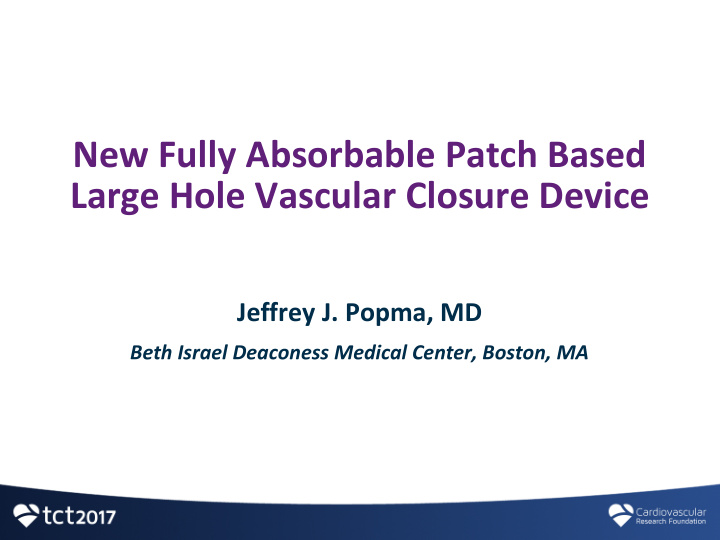



New Fully Absorbable Patch Based Large Hole Vascular Closure Device Jeffrey J. Popma, MD Beth Israel Deaconess Medical Center, Boston, MA
Disclosure Statement of Financial Interest Over the past year, I have received the following: Institutional Grants: Medtronic, Boston Scientific, Abbott Vascular, Edwards, Cook Medical Advisory Board: Boston Scientific Consultant: Cordis, Edwards 1
Drivers of Clinical Need in Large Bore Vascular Closure Desired Approach: TAVR Fully percutaneous TEVAR EVAR Easy to use ECMO Safe and secure Fully bioabsorbable Challenge: 1-5% complications associated with currently available large hole closure
PerQseal External Locator Scaffold Designed for large arteriotomies Simple OTW operation All components fully absorbable from same synthetic polymer Patch Seals from inside Day 180 Day 1 Up to 24F holes No suture, collagen or metal components
PerQseal Three Step Device Deployment Loading cannula connect to the introducer hub Device handle connects with the introducer hub forming an integrated unit Sheath actuator is rotated 180 degree clockwise releasing the outer sheath and exposing the implant patch Delivery system is retracted until the patch contacts the arterial wall Guidewire removed Release actuator rotated 180 degree clockwise External locator secures implant
Pre-Clinical Gross Pathology Porcine abdominal aorta 32 Day post implantation 91 Day post implantation Implant Endoluminal coverage of the Implant patch absorbed, foot implant by mature, stable and section migrated extra- arterial generally endothelialized and absorbing neointima
Pre-Clinical Histology 30-180 days post implantation Implant Implant Implant absorbing and Absorbed Encapsulated extra-arterial Cross-section Cross-section Cross-section @ 32 days @ 180 days @ 91 days 162 days post implantation Porcine abdominal aorta – luminal surface 22F Arteriotomy Implantation site Complete absorption Implantation site undifferentiated from native arterial wall Longitudinal histology @ No granuloma/scaring 162 days No perivascular fibrosis
Clinical Experience 77 year old Male, Ht. 175 cm, Wt. 63 kg Med: 15 mg q.d. rivaroxaban TAVR Edwards 16F SAPIEN 3 29mm valve Closure Vivasure PerQseal Dr Peter Crean, St. James Hospital, Dublin, Ireland
Clinical Program TAVR: Study Type # sites # Cases EVAR:TEVAR Frontier I* FIM 2 12 10:2:0 Frontier II* CE Mark 8 46 25:20:1 Frontier III* CE Mark 6 62 42:16:4 Enrolling Frontier IV Indication Expansion 12 75 On-going Planned Registry Post market 15+ 300+ US IDE US approval 15+ 200+ * No acute major device related vascular complications * No late major or minor device related vascular complications
Overall Clinical Experience Over 120 patents implanted (9 centres across EU) TAVR EVAR TEVAR No major VARC-II vascular complications (no roll ins) Follow up assessments completed (30d, 90d, 1yr) No late major or minor device related vascular complications No clinically significant stenosis, turbulence, aneurysm formation on follow-up Ultrasound scans CE Mark
Clinical Experience Vessel patency post-implantation Pre-implantation Peri-procedure tamponade < 15 min. Post-implantation Implant Implant Delivery shaft Low profile, non-stenosing absorbable implant
Clinical Experience 1 mo. Post-procedure Pre-procedure
Clinical Experience EVAR - bilateral arteriotomy closures Pre-Implantation 2 days Post Implantation
Technology Development PerQseal EVAR VAD PFO TAVR TMVR BAV LAA TEVAR
PerQseal Summary Easy to use device with low learning curve Patch-based, fully absorbable implant Requires no pre-procedure steps Has clinically demonstrated its safety and effectiveness with excellent outcomes from discharge through 12 month follow-up (>120 patients in Frontier studies) Device provides a real option for fully percutaneous closure with the potential to reduce hospital costs and procedure times Proprietary polymer technology promising in expanded vascular indications
Recommend
More recommend